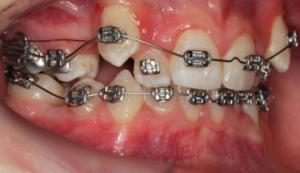What is the best aligning arch wire? A Cochrane Systematic Review
There are many types of aligning archwires, but which is the best? This new Cochrane Review provides us with some information.
The first trial that I did looked at the effectiveness of two aligning archwires. We had not done a trial before, so we got a book out of the library and followed the instructions! We made many mistakes in this study. The most obvious was that the wires did not have different mechanical properties. It was, therefore, no surprise that they did not differ in their clinical performance. Since then many investigators have looked at the effects of different aligning archwires. The results of their studies are somewhat mixed. As a result, this updated Cochrane Review is timely.
A team from China and Dundee, Scotland did this review. It was an updated review.
 Initial arch wires used in orthodontic treatment with fixed appliances
Initial arch wires used in orthodontic treatment with fixed appliances
Wang Y, Liu C, Jian F, McIntyre GT, Millett DT, Hickman J, Lai W.
Cochrane Database of Systematic Reviews 2018, Issue 7. Art. No.: CD007859. DOI: 10.1002/14651858.CD007859.pub4.
They set out to assess the effects of different archwires in the aligning stage of orthodontic treatment.
What did they do?
The PICO was
Participants: Orthodontic patients who were treated with fixed appliances
Intervention: Any aligning arch wire
Comparator: Other aligning wire
Outcome: The primary outcomes were the rate of alignment and the incidence/prevalence and amount of root resorption. Secondary outcomes included time to alignment and pain.
They only included randomised controlled trials.
They did a standard electronic database search, followed by relevant hand searches and review of secondary references. Finally, they also contacted the authors of all the studies that they wanted to include to clarify details of the studies.
Two authors assessed the titles, carried out an assessment of risk of bias with the Cochrane Risk of Bias tool and extracted the data. They then did the relevant meta-analysis.
What did they find?
They identified 12 RCTS, this included 3 new studies. This provided data on 799 participants, which is a substantial number for orthodontic reviews.
When they looked at risk of bias, they classified three to be at high risk of bias (including the one that I did!), three were low risk and they felt that six were unclear.
They made several comparisons between the archwire types. For most of these they concluded that there was insufficient evidence to determine if there were differences. I do not have sufficient space to go through all their comparisons. However, I felt that two were clinically important.
They did not find a difference between multi strand stainless steel and superplastic Ni-Ti in terms of rate of alignment or pain experience. This was a moderate level of evidence.
They found one study that showed that coaxial superelastic Ni-Ti produced greater tooth movement over 12 weeks than single strand superelastic Ni-Ti. The mean difference was 6.7mm over 12 weeks. This was a moderate level of evidence. However, this was a small trial of 24 patients and the confidence intervals were rather wide (7.98-5.55).
What did I think?
This was a Cochrane Review. These are generally carried out to a high standard, as the editorial team is rather demanding and expect reviewers to follow a strict protocol. There are also multiple quality control checks and the final editorial process is tough. As a result, these reviews are well carried out and reported. So, it was no surprise for me to conclude that this was a good review.
The conclusions were clear. However, some people may find that these are disappointing because they did not find any real differences. While this is not unusual for orthodontic reviews, I feel that the results are interesting. One of the most clinically relevant is that they did not detect a difference in tooth movement between stainless steel multi strand wires and single strand NiTi. We need to remember that this is an “absence of evidence” and this does not mean that there is no difference between the wires, it is just that they did not find any evidence that suggests this.
Some may say that this means that we should be using the cheaper multi strand wires. However, clinical experience suggests that this would not be a good step. I still remember seeing very large traumatic ulcers after I fitted multistrand wires and the ends had become frayed.
This review also emphasises a conclusion of a large amount of research into brackets and wires. These have limited effect, the greatest influence on treatment is likely to be the operator. There are still no magic wires or brackets.

Emeritus Professor of Orthodontics, University of Manchester, UK.
So how do companies who sell Fast Braces/ 6mth etc courses be allowed to tell dentists that their wires and brackets are better? And the bigger problem is the dentists who believe them.
all dentists and orthodontists are trained to evaluate the literature and undertake evidence based care. Any clinician that suggests that they can “do in 6 months that conventional braces would take 18-24 months to achieve” is obviously a liar and should be reported to their regulatory body. Similarly any company suggesting the same should be reported to the advertising standards authority (UK) who will take action against this flagrant and malicious false advertising
In my private practice I have used many types of wires and from different companies, in my experience the quality and form of the arch wires are very important, and shortens the treatment
I agree with Dr Brian, it’s up to the orthodontist, how they make use of the wires which will help them reduce the treatment time.
“The mean difference was 6.7mm over 12 weeks. ”
Is this a typo? Should it be 0.67 mm?
Thanks for the comment. This number is correct.